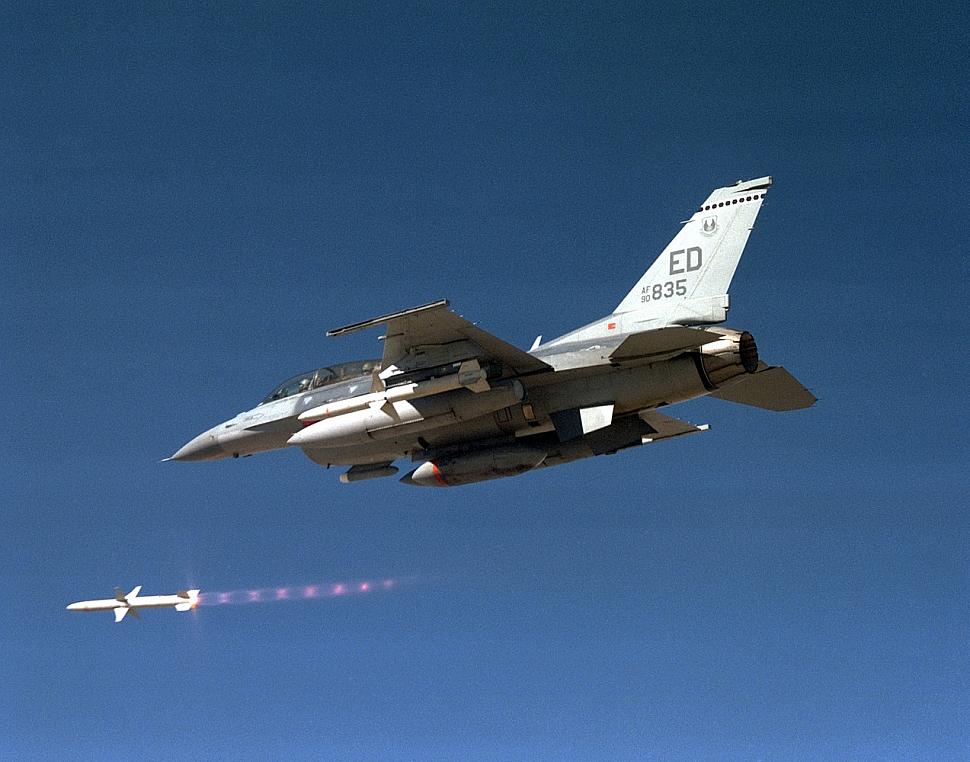Fighter Jet News
F-16 Fighting Falcon News
HDAM launched from an F-16 successfully hits target without radar guidance
November 24, 2006 (by
Lieven Dewitte) -
Raytheon again successfully demonstrated the enhanced navigation accuracy capability of a new variant of HARM (High-speed Anti-Radiation Missile) at China Lake.
The Block VI called "HDAM" for HARM Destruction of enemy air defense Attack Module, adds INS/GPS (inertial navigation system/global positioning system) capability to the battle-proven HARM, greatly improving its effectiveness while significantly reducing collateral damage and the threat to friendly troops.
The test flight took place at the China Lake Test Range, Calif. The missile, launched from an F-16, was fired against a simulated surface-to-surface missile launcher.
The target was not emitting radar signals -- the normal target locater used by the current HARM system. In this case the missile was given the target's geographic location.
After launch the missile flew a range-enhancing profile and the fuze successfully activated over the target well within the required parameters. Pieces of the destroyed target were observed flying through the air, which was significant as the missile was not carrying a warhead.
The first test on June 20 saw HDAM, also launched from an F-16, successfully face two radar sources and select the correct one. The test demonstrated that the added INS/GPS capability ensures that the intended target is attacked instead of other radar sources.
"The combination of the excellent long range targeting provided by the F-16, and HDAM's supersonic precision attack, gives the warfighter a way to destroy critical targets at extended ranges," said Jeff Wadsworth, the HARM program director at Raytheon Missile Systems in Tucson, Ariz. "The target no longer needs to identify itself by radar emission to be neutralized."
"HDAM can quickly be adapted to a new role as a high-speed strike weapon with impressive range," Wadsworth said. "Raytheon is already researching new technology that gives the HDAM increased effectiveness over a wide range of target sets."
Raytheon Missile Systems has produced more than 22,800 HARMs since 1985. Customers include the U.S. Air Force, Navy, Marines and seven international allies.
A HARM costs about $300,000; the newer HDAM will obviously cost a little more.
The test flight took place at the China Lake Test Range, Calif. The missile, launched from an F-16, was fired against a simulated surface-to-surface missile launcher.
The target was not emitting radar signals -- the normal target locater used by the current HARM system. In this case the missile was given the target's geographic location.
After launch the missile flew a range-enhancing profile and the fuze successfully activated over the target well within the required parameters. Pieces of the destroyed target were observed flying through the air, which was significant as the missile was not carrying a warhead.
The first test on June 20 saw HDAM, also launched from an F-16, successfully face two radar sources and select the correct one. The test demonstrated that the added INS/GPS capability ensures that the intended target is attacked instead of other radar sources.
"The combination of the excellent long range targeting provided by the F-16, and HDAM's supersonic precision attack, gives the warfighter a way to destroy critical targets at extended ranges," said Jeff Wadsworth, the HARM program director at Raytheon Missile Systems in Tucson, Ariz. "The target no longer needs to identify itself by radar emission to be neutralized."
"HDAM can quickly be adapted to a new role as a high-speed strike weapon with impressive range," Wadsworth said. "Raytheon is already researching new technology that gives the HDAM increased effectiveness over a wide range of target sets."
Raytheon Missile Systems has produced more than 22,800 HARMs since 1985. Customers include the U.S. Air Force, Navy, Marines and seven international allies.
A HARM costs about $300,000; the newer HDAM will obviously cost a little more.

